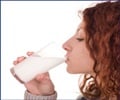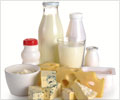Health benefits of high intake of milk products have not been established and concerns exist about the dangers of possible adverse health outcomes.
Highlights :
- The use of milk and other dairy products has been justified to meet nutritional requirements for calcium and reduce the risk of bone fractures
- If the mother’s milk is not available in infancy, cow’s milk may provide a valuable substitute in promoting growth velocity and greater attained the height
- However, if the diet is of high quality, higher milk consumption can do more harm to our health and environment
Read More..
Milk for Growth and Development
Milk has all the nutrients that are needed to nourish and promote the growth of young mammals. Cow’s milk has a complex combination of macronutrients, micronutrients, and growth-promoting factors that can contribute to human nutrition in the absence of breast milk. But, normal growth and development can be obtained throughout childhood without dairy products. This can be done by giving attention to diet quality, including the use of supplemental B12, and vitamin D to compensate for low sun exposure.Milk consumption increases longitudinal growth and attained height. Though height is associated with lower cardiovascular disease risk, it can increase the risk of many cancers, hip fractures, and pulmonary emboli.
The growth-promoting effect of milk is not clear. Cow’s milk contains branched-chain amino acids leucine, isoleucine, and valine. Consumption of these amino acids by humans mediate growth hormone action, which may be responsible for the increase in longitudinal growth.
Fracture Risk
Milk increases the attained height of a child and makes them taller. However, this is also strongly related to fractures of the hip and other bones. During adolescence, high milk consumption was associated with a greater risk of hip fracture later in life for every additional glass consumed per day, especially among men. No such association was seen among women. There are no studies that support high intakes of milk during adolescence to prevent fractures later in life. Such consumption may contribute to the high incidence of fractures in countries with the highest milk consumption.Obesity and Weight-Gain
Analysis of many randomized trials has shown that there are no overall effects of milk consumption or other dairy foods on body weight, both in children and adults. The use of whole milk, low-fat milk, and cheese had no associations with weight change, while fermented products like yogurt consumption were associated with less weight gain. Yogurt is a rich source of probiotic that positively affects the gut bacteria and may protect against obesity.Consumption of low-fat milk does not reduce body weight more than sugar-sweetened beverages, fruit juice, or water. Low-fat milk does not appear to have advantages over whole milk for weight control. In children, evidence suggests long-term weight gain with reduced-fat milk than with full-fat milk. Regular yogurt consumption may result in less weight gain, but this warrants further study.
Diabetes
It is believed that the cross-reactivity between proteins in cow’s milk and pancreatic islet cells can cause type 1 diabetes, though the relationship remains unclear. In some studies, the intake of dairy products is associated with a modestly lower risk of type 2 diabetes. Few other studies have shown that the risk of diabetes was lower with milk consumption than with consumption of sugar-sweetened beverages or fruit juices but higher with milk consumption than with coffee consumption.Effect on Blood pressure, Lipids and Cardiovascular Health
The high potassium content of milk has led to the suggestion that greater milk intake may reduce blood pressure. But randomized trials of low-fat milk have shown inconsistent results with respect to the reduction of blood pressure. But in such trials, the effect of milk often depends on the comparison of beverages or foods. If milk replaces sugar-sweetened beverages or other refined carbohydrates, outcomes will probably be beneficial, but results may differ if milk replaces nuts, legumes, or whole fruits.It is recommended to consume low-fat dairy products instead of full-fat alternatives because saturated fat increases low-density lipoprotein (LDL) cholesterol, and increased LDL cholesterol, which is bad for heart health.
In some prospective cohort studies, no specific association whole milk or low-fat milk with the incidence of, or mortality associated with, coronary heart disease or stroke was established. It also depends on other comparison foods. When diets are very high in starch, especially in low-income countries, moderate dairy intake may reduce cardiovascular disease by providing nutritional value and reducing glycemic load.
Milk and Cancer Risks
Consumption of dairy products increases the risk of breast cancer, prostate cancer, and other cancers. In prospective cohort studies, milk consumption is associated with a greater risk of an aggressive form of prostate cancer, but not with a greater risk of breast cancer.Dairy intake has been associated with a greater risk of endometrial cancer, and ovarian cancer particularly among postmenopausal women who are not receiving hormone therapy.
Milk consumption reduced the risk of colorectal cancer, probably due to high calcium content.
Lactose Intolerance and Allergies
Around 4% of infants are allergic to cow’s milk proteins which can cause nutritional problems and allergic diseases. Milk consumption increases predisposition to asthma, eczema, and food allergies, that can remain beyond childhood.Another study of children with intolerance to cow’s milk showed that children who consumed soy milk had a reduction in symptoms like anal fissures, whereas there was no reduction in symptoms among children in the group that received cow’s milk.
Lactose intolerance is a global problem that limits the consumption of milk worldwide.
Milk and Mortality
Consuming low-fat dairy products did not affect mortality, while whole milk was associated with higher total mortality. Total intake of dairy foods was not associated with overall mortality.When major protein sources were compared, dairy foods consumption was associated with lower mortality than consumption of processed red meat and eggs.
Organic Milk and Grass-Fed
Organic milk is thought to have better nutritional values than conventionally produced milk because of concern about the use of recombinant bovine somatotropin and residues of pesticides and antibiotics.Organic milk may have slightly higher amounts of polyunsaturated fatty acids and beta carotene than conventional milk, which may result from grass-feeding.
Milk Production and Greenhouse Effects
Production of foods often influences health both directly and indirectly through the environmental effects. The effects of dairy production on greenhouse gas production and climate change, water use and pollution, and antibiotic resistance are large. Limiting dairy production could make a major contribution toward reaching international greenhouse-gas targets.In summary, cow’s milk is highly nutritious and has growth-promoting factors that can contribute to human nutrition. However, current evidence clearly shows that these nutrients can be obtained from other sources too and this can help lower our consumption of dairy products and this, in turn, can be of benefit to our health and the environment.
- There is a lack of evidence that supports high dairy consumption can reduce fractures.
- Dairy consumption has not been clearly related to weight control or risk of diabetes and cardiovascular disease.
- High consumption of dairy foods is likely to increase the risks of prostate cancer and possibly endometrial cancer but reduce the risk of colorectal cancer.
- Dairy foods are beneficial compared to processed red meat or sugar-sweetened beverages but less favorable than plant-protein sources such as nuts.
- The absence of mother’s milk in early childhood, cow’s milk may provide a valuable substitute by promoting growth velocity and greater attained height, which confer both risks and benefits.
- In children from low-income environments if the diet quality is low, dairy foods can improve nutrition.
- Adequate nutrition does not warrant a high milk consumption as it may increase the risk of fractures later in life and the risk of cancers.
- Calcium and vitamin D can be obtained from other foods or supplements without the potential negative consequences of dairy foods. Kale, broccoli, nuts, beans, tofu,and fortified orange juice are rich sources of calcium, while vitamin D supplements are better and more affordable than fortified milk.
- Limiting dairy production could help the world reduce greenhouse effects and climate change
- Milk and Health - (https://www.nejm.org/action/showFullText?downloadfile=showFullText&journalCode=nejm&journalCode=nejm&journalCode=nejm&journalCode=nejm&journalCode=nejm&journalCode=nejm&journalCode=nejm&journalCode=nejm&journalCode=nejm&journalCode=nejm&doi=10.1056%2FNEJMra1903547&loaded=true)
Source-Medindia















